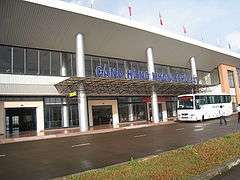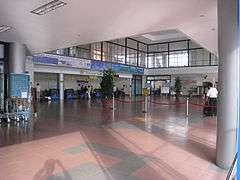Phu Cat Airport
| Phu Cat Airport Sân bay Phù Cát | |||||||||||
|---|---|---|---|---|---|---|---|---|---|---|---|
| Summary | |||||||||||
| Airport type | Public/Military | ||||||||||
| Operator | Middle Airport Authority | ||||||||||
| Serves | Qui Nhơn | ||||||||||
| Location | Phù Cát District | ||||||||||
| Elevation AMSL | 24 m / 79 ft | ||||||||||
| Coordinates | 13°57′18″N 109°02′32″E / 13.95500°N 109.04222°ECoordinates: 13°57′18″N 109°02′32″E / 13.95500°N 109.04222°E | ||||||||||
| Website | http://phucatairport.vn | ||||||||||
| Map | |||||||||||
 UIH Location of the airport in Vietnam | |||||||||||
| Runways | |||||||||||
| |||||||||||
| Statistics (2015) | |||||||||||
| |||||||||||
Phu Cat Airport (IATA: UIH, ICAO: VVPC) (Vietnamese: Sân bay Phù Cát) is the airport serving Qui Nhơn, Vietnam. It is in Phù Cát District between the towns of Ngo May and Đập Đá, around 30 kilometres (19 mi) northwest of Qui Nhơn within Bình Định Province along the South Central Coast of Vietnam.
As well as being a commercial airport, Phu Cat is also used by the Vietnamese Air Force (Khong Quan Nhan Dan Viet Nam).
Phu Cat Airport is the hub of newly Vietnamese Carrier Bamboo Airways .
Airlines and destinations and flights
| Airlines | Destinations |
|---|---|
| Jetstar Pacific | Hanoi ,[4] Ho Chi Minh City |
| VietJetAir | Hanoi,[5] Ho Chi Minh City |
| Vietnam Airlines | Hanoi, Ho Chi Minh City |
History
Phù Cát Airport was built in 1967 during the Vietnam War for the United States Air Force (USAF) by the American construction company RMK-BRJ. During the war, it was a major air base for the Republic of Vietnam Air Force and USAF. Until 1975, the airport was known as Gò Quánh Airport. The airport was one of the major sites for Agent Orange recharge besides Bien Hoa Air Base and Da Nang Air Base. Due to heavy activities involving dioxin during the war, the ground at the airport was polluted with toxic chemicals and cleanup efforts are still ongoing. After 1975, it was used for training purpose by the Vietnamese Air Force and subsequently developed into a mixed-use airport for both regional civic air transport and military activities in 1984 following the suspension of civic service at nearby Qui Nhơn Airfield. In September 1984, the airport served its first commercial flight.[6]
On July 10, 2003, construction on a new 3,000 m2 (32,000 sq ft) passenger terminal for the airport started. The terminal was completed in June 2004. It has a capacity of 600,000 passengers per year with 2 airplane gates, 6 check-in counters and 2 conveyor belts.[6] The airport handled 420,000 passengers in 2014 and held an average 46% annual growth in passengers. The airport served 1.5 million passengers in 2017.
On February 13, 2017, works started on the site of a new passenger terminal for Phu Cat Airport. This terminal, built on a cost of US$22 million, would have a capacity of 1.5 million passengers per year with room for expansion up to 2.4 million. The new terminal opened on May 3, 2018 and completely replaced the 2003-built terminal.[7]
Gallery
 Terminal at the airport
Terminal at the airport Interior of the Passenger terminal
Interior of the Passenger terminal A Vietnam Airlines Airbus A320 at the airport
A Vietnam Airlines Airbus A320 at the airport
See also
References
- 1 2 Trí Dũng. "Bình Định đề xuất xây Nhà ga hành khách sân bay Phù Cát". Thời báo Tài chính Việt Nam. Retrieved 2 September 2018.
- ↑ Airport information for VVPC at Great Circle Mapper.
- ↑ Airport information for Phu Cat Airport at Search (for) Travel website.
- ↑ "Jetstar Pacific Adds New Domestic Routes from June 2016". airlineroute. Retrieved 2 May 2016.
- ↑ http://m.thanhniennews.com/travel/vietjet-announces-hanoiquy-nhon-flights-37805.html
- 1 2 "Giới thiệu". Cảng hàng không Phù Cát (in Vietnamese). Retrieved 6 June 2018.
- ↑ "Đưa vào khai thác Nhà ga hành khách Cảng hàng không Phù Cát". Airports Corporation of Vietnam. Retrieved 7 June 2018.
External links
- Airport information for VVPC at World Aero Data. Data current as of October 2006.
| Wikimedia Commons has media related to Phu Cat Airport. |